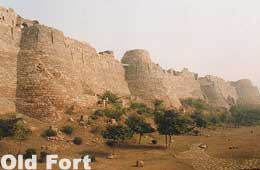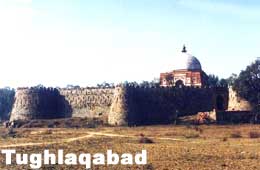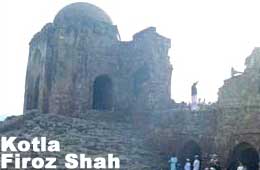| India Profile » Monuments and Temples in India » Forts of Delhi | |
Forts of Delhi | |
 | |
|
Indraprastha A history of Delhi begins with the creation of the Indraprastha by the Pandavas in c. 1450 BC. It was designed by the legendry architect Maya who made the magnificent palaces and courts for the Pandavas. Recent findings in the archaeological excavations have proved that the city of Indraprastha was located in the Purana Qila or the Old Fort area and was in continuous occupation up to 1000 BC. Delhi fell into oblivion with the decline of Buddhism and remained unimportant when the neighboring cities of Mathura and Kannauj flourished.
Lal Kot or Qila-I-Rai Pithora Lal Kot was built by the Tomar ruler Anangpal I in about 731 A.D and said to have been rebuilt by Anangpal II in 11th century when he transferred the Capital from Kannauj to Delhi. The Chauhans defeated the Tomars in 12th century AD. Prithviraj extended the old city of Lal Kot and added ramparts and moat. Prithviraj was also known as Rai Pithora and thus it came to be known as Qila-I-Rai Pithora, the first city of Delhi. Lal Kot was an oblong structure having seven gates-Sohna, Ranjit, Ghazni, Hauz Rani, Barka, Budaun and Maya. Only ramparts are visible near the Qutub Minar although it is said to have had several Jain and Hindu temples. Mohammad Ghori invaded India towards the end of the 12th century AD from Afghanistan and defeated Prithviraj and occupied Delhi. He, however, returned to Afghanistan after leaving his new kingdom in the hands of his slave Qutub-ud-din Aibak. The Lal Kot continued to be the capital till 1303 AD. Siri Fort
Tughlaqabad Ghazi Malik, famous as Ghiyas-ud-din, founded the Tughlaq Dynasty in 1321 AD. He built the strongest fort in Delhi at Tughlaqabad, which was completed a great speed of four years of his rule. Tughlaqabad is the third city of Delhi. The fort has slanting walls, double-storeyed bastions, gigantic towers, palaces, mosques and audience halls. It was deserted soon after the death of Ghiyas-ud-Din probably because of scarcity of water or because of the new capital built by Mohammad Bin Tughlaq. Jahanpanah Muhammad Bin Tughlaq first built Adilabad then Nai-ka-Kot towards the south of Tughlqabad. They are two small fortresses. But he soon abandoned it. He built a new city by enclosing the areas lying between the cities of Siri, Tughlaqabad and Lal Kot. The city was named as Jahanpanah, asylum of the world in 1334 AD. The city had 13 gates. The ruins of gigantic ramparts of his two fortresses and some portions of the Jahanpanah walls have survived the ravages of time but are in ruins. The watchtower Bajai Mandal still stands in ruins in the city of Jahanpanah. Kotla Firoz Shah or Firuzabad
Old Fort or Purana Qila The Old Fort was the citadel of the city of Dinpanah, Refuge of the Faithful. It was started by Humayun in 1533 AD and completed five years later. When the Afghan King Sher Shah Suri defeated Humayun, he renamed the fort as Shergarh. Sher shah is also credited with adding many more buildings in the complex. There are three entrances to the Purana Qila out of which only one remains open and is used as the entrance these days. It is called the Bara Darwaza. The south gate is called the Humayun Gate probably because it was constructed by Humayun or Humayun's Tomb is visible from there. The third gate is known as the Talaqi Gate. Qila-I-Kuhna Masjid is an imposing mosque constructed by Sher Shah in 1541 AD. The central portion of the mosque is made up of white marble and bright red sandstone. The inner western wall called the qibla wall of the mosque has five arched openings richly ornamented in white and black marbles. Sher Shah constructed another building, the Sher Mandal, as a pleasure tower. It is an octagonal building made up of red sandstone. The two-storeyed pavilion has steep steps leading up to the roof. The structure was intended to be higher than its existing height but the work was stopped due to untimely death of Sher Shah. When Humayun recaptured Delhi in 1555 AD, he converted the Sher Mandal into his library and observatory. Humayun fell from the steps of this building a year later while he was coming down for his namaz. Fort of Salimgarh The Fort of Salimgarh is adjacent to the Lal Qila across the Ring Road. It was built by Sher Shah Suri's son Salim Shah. It was an island fort encircled by the river Yamuna. The bridge on the north connects the red Fort with the Fort of Salimgarh. It was used by the British as a prison for the freedom fighters. The fort was renamed as Swatantrata Senani Smarak after the Independence. Red Fort or Lal Qila
The fort contains all the important buildings of Mughal government like the Halls of Public and Private Audience Diwan-I-Aam and Diwan-I-Khas, marble palaces, private apartments, a mosque and elaborately designed gardens. It was attacked by the Persian Emperor Nadir Shah in 1739 AD and by the British soldiers during the war of independence in 1857. Entrance to the fort is through the imposing Lahore Gate, which takes its name from the fact that it faces Lahore, now in Pakistan. This gate was built by Aurangzeb during his reign and is also known as the Laj Ki Diwar. There is a story that the bazaar of Chandini Chowk was visible from the Diwan-I-Aam. The nobles had to mount down the horse while crossing the bazaar when the emperor was presiding over the hall. Aurangzeb got the wall constructed to make the nobles free from discomfort. The main entrance of the Red Fort opens towards the Chatta Chowk, which was a covered street flanked with arched cells. The street used to house Delhi's most talented jewelers, carpet makers, weavers and goldsmiths. This arcade was also known as the Meena Bazaar and was the shopping center for the ladies of the court. Beyond the Chatta Chowk is the Naubat Khana or the Drum House. The musicians used to play for the emperor from the Naubat Khana and the arrival of princes and royalty was heralded from here. The other attractions within the Red Fort are the Royal Baths or Hammams, the Shahi Burj, Shahjahan's private working area and the Moti Masjid or the Pearl Mosque, built by Aurangzeb for his personal use. The Rang Mahal or the Palace of Colors was the living chamber of the Emperor's wives and mistresses. This palace was crowned with gilded turrets, delicately painted and decorated with an intricate mosaic of mirrors, and a ceiling overlaid with gold and silver that was reflected in a central pool in the marble floor. |
|
 |
 Delhi is one of the oldest living cities in the world with almost 20,000 ancient monuments. Delhi has a rich history and the monuments of Delhi are its evidence. Delhi is not a single city but a combination of eight cities that have been established here at various point of time from as early as 900 BC to 1930 AD when the British completed the construction of New Delhi as the capital of imperial India. It is, therefore, the monuments of Delhi successfully represent the development of several architectural styles in the country.
Delhi is one of the oldest living cities in the world with almost 20,000 ancient monuments. Delhi has a rich history and the monuments of Delhi are its evidence. Delhi is not a single city but a combination of eight cities that have been established here at various point of time from as early as 900 BC to 1930 AD when the British completed the construction of New Delhi as the capital of imperial India. It is, therefore, the monuments of Delhi successfully represent the development of several architectural styles in the country.
 The city of Siri was the second city of Delhi built by Ala-ud-din Khilji in 1311 AD. The fort had the Palace of Thousand Pillars, which is now in ruins. Only the embattlements have left of the entire fort. The story goes that Ala-ud-din got the heads of the infidels whom he had got killed dug in the foundation of the fort. The fort thus got its name as the Siri Fort. But there is no supporting evidence to believe this story. Ala-ud-din built a vast water reservoir, Hauz-I-Shamsi in the present Hauz Khas area to have a continuous supply of water in the city.
The city of Siri was the second city of Delhi built by Ala-ud-din Khilji in 1311 AD. The fort had the Palace of Thousand Pillars, which is now in ruins. Only the embattlements have left of the entire fort. The story goes that Ala-ud-din got the heads of the infidels whom he had got killed dug in the foundation of the fort. The fort thus got its name as the Siri Fort. But there is no supporting evidence to believe this story. Ala-ud-din built a vast water reservoir, Hauz-I-Shamsi in the present Hauz Khas area to have a continuous supply of water in the city.
 Firoz Shah built a new capital city on the banks of the River Yamuna in 1351 AD and called it Firuzabad. The architecture of the fort was fairly simple and straightforward. The city had three palaces and a citadel known as Firoz Shah Kotla. The king's as well as his wive's quarters were situated along the riverfront. The structures within the enclosure walls of the fort were barracks, armories, servant's rooms, halls for audience, an imposing mosque as well as public and private baths and a stepped well or baoli. An Ashokan pillar brought from Topara, Ambala was mounted on top of a pyramidal three-tiered construction.
Firoz Shah built a new capital city on the banks of the River Yamuna in 1351 AD and called it Firuzabad. The architecture of the fort was fairly simple and straightforward. The city had three palaces and a citadel known as Firoz Shah Kotla. The king's as well as his wive's quarters were situated along the riverfront. The structures within the enclosure walls of the fort were barracks, armories, servant's rooms, halls for audience, an imposing mosque as well as public and private baths and a stepped well or baoli. An Ashokan pillar brought from Topara, Ambala was mounted on top of a pyramidal three-tiered construction.
 The Red Fort or Lal Qila was the part of the city of Shahjahanabad. The fort was started in 1638 AD and completed in 1648 AD by Shahjahan. It is built of red sandstone and has turrets and bastions. The fort is surrounded by a moat in the northeast corner of the city. The wall is two km long and varies in height from 18 m on the riverfront to 33 m in the city.
The Red Fort or Lal Qila was the part of the city of Shahjahanabad. The fort was started in 1638 AD and completed in 1648 AD by Shahjahan. It is built of red sandstone and has turrets and bastions. The fort is surrounded by a moat in the northeast corner of the city. The wall is two km long and varies in height from 18 m on the riverfront to 33 m in the city.